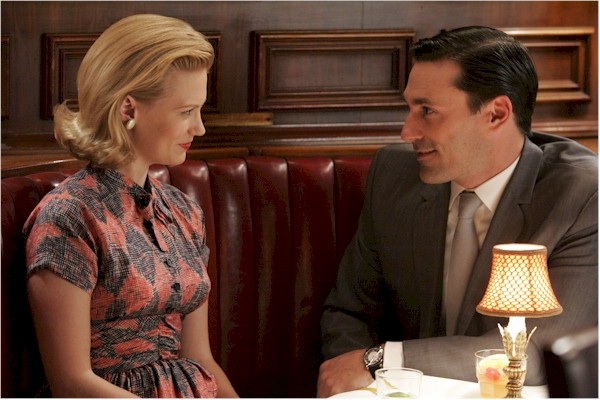Sunday, August 16th, begins the third season of the exceptional AMC original series, “Mad Men.” The show is about a private Madison Avenue (hence the “Mad” in “Mad Men”) advertising firm, set in the early 60s. This show somehow touches all my subterranean hot buttons. “Mad Men’s” second season ended in the year 1962, at the conclusion of the Cuban Missile Crisis, as the firm is about to be acquired by a London based agency. The second season’s finale was a perfectly coordinated display of the several character centered subplots, each reaching a critical turning point simultaneously. My tendency to see politics in everything is thwarted by this show, even as it is easily parodied politically, given current “mores and folkways.” But I’ll give it a shot.

The show has an uncanny ability to convince the audience it is watching people as they were then, with no intrusion of modern sensibilities and judgments. The show’s appearance is a gauzy impressionism, which helps create a nostalgic effect. There seems to be less dialogue than most shows. Characters are developed as much through facial reactions to events as with dialogue and plot lines. When watching the show, it feels like 1962, as I nostalgically remember it, even though I never heard of Madison Avenue until years later. Plot lines are about getting and losing clients, and they can be amusing. But plots are primarily designed to create interest in each character.
The characters are subtly drawn, but are still “sharp line bright.” The leading character is “Don Draper” (Emmy winner Jon Hamm), the strong-willed, supremely confident yet flawed head of “Creative” for the midsized firm “Sterling Cooper.” Draper lives an upper middle class suburban life, early ’60s style, and is married to an ex-model, mid-level socialite named Betty (January Jones). But Don Draper is really “Dick Whitman,” a secret known with certainty by only two people, the real Draper’s wife, who the new Draper financially supports, and weirdly, an aggressive young sales executive at Sterling Cooper, “Pete Campbell” (Vincent Kartheiser).
In flashbacks, we learn the real Draper and Whitman were caught alone in a firefight in the Korean War. After the fight, the real Draper was burned alive, in part because Whitman “pissed his pants,” which crazily triggered a live fire killing Draper. Whitman was raised by accidental adoptive parents, as his real parents died a few years apart, each remarrying. He desperately sought to erase his past, switched “dog tags” with the real Draper and became him. Don Draper becomes a man with no past.
Women in the show could be called stereotypes of the era. While true, that perception misses the mark. Betty kicks Draper out of the house for his serial adultery, for which she has no proof. Women’s’ roles are different, and indeed partially subordinate. But they are not weak. Sexual harassment was a concept unknown in 1962. In fact, there is constant sexual tension throughout the show between the Mad Men and their secretaries, which all seem to accept. Smoking and drinking during work hours seem required.
The most intriguing character is “Peggy Olsen” (Elizabeth Moss). She is a high school graduate, a secretary, and a confused but believing Catholic from Brooklyn. By second season’s end she is a senior copywriter with creative instincts surpassing the Ivy Leaguers (in importance, if not pay). She asks senior partner Roger Sterling (John Slattery) if she can have a recently vacated large office, as he passes her casually in the halls. He gives it to her. He states in a bemused and condescending fashion, “you modern girls are quite aggressive, I like that. None of these guys had the balls to ask.” In her outwardly quiet, attractive, mousy way, she dominates them intellectually and psychologically.
Olsen is really Draper’s doppelganger. She also tries to erase her past. She “consents” to sex early in Season One to Pete Campbell. She gets pregnant but manages to not notice. She eventually enters a hospital with stomach pains and delivers a baby she refuses to even look at. Her sister raises it. Her denial leads to temporary insanity in the hospital. Draper, knowing his Doppelganger when he sees her, visits, and mentally forces her to confront reality and “move on.” She moves on.
The show is focused on “inner life.” The characters seem like “prisoners” of background and circumstance. Yet they have free will and the power to transcend circumstances, if existentially aware. We, and they, have limits too. Each person needs to find their way. The show’s two “protagonists,” Draper and Olsen, have morally compromised lives. They realize this. They seek redemption, but are also driven to succeed in work, and these two can conflict. They struggle, and as such, are appealing. Is there an implicit political message in this show, a bias perhaps, a hidden jab at the left, or right? Not that I can see. However, what is not seen may be as interesting or telling.
What is not seen? Government. The Nixon/Kennedy election takes up one episode. They all want Nixon to win, but it is not clear why. Perhaps they expect a more friendly business environment. One Mad Man, who fancies himself an intellectual, marches in Mississippi with his black girlfriend (who then blows him off, amusingly). That’s about it. Government policies and politics simply are absent, accept as it might relate to business. No political correctness or anti-political correctness is visible. Just people living day-to-day, trying to make it. Some have broader imaginations than others. Some are nasty, some are brilliant, some are dopes or comical.
Yet no one is looking to “leaders” for salvation. Refreshing.
COMMENTS
Please let us know if you're having issues with commenting.